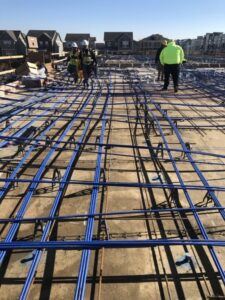As a structural designer, I started my career working on post-tension structures. Those of you who have been with us for some time know that those can include things as small as a single tennis or basketball court as well as some of the tallest buildings on the Denver skyline.
Half-inch diameter post-tension tendons are initially stressed with a jack that turns out 33,000 pounds of force. When the jack is removed, a pair of hardened steel wedges bite into the strand, locking it into the anchor. Those wedges allow about 1/4″ of strand to pass through before they engage, reducing the force in the tendon.
Once the wedges have seated, the anchor transfers the force from the tendon into the slab. This may be as much as 29,000 pounds. However, a number of surprising things start to happen almost immediately.
First, the slab almost instantly gets shorter. Laymen don’t generally think of concrete being elastic, but it is – and engineers are constantly aware of that fact when they are designing any structure. 29,o00 pounds per cable multiplied by 40 cables is enough to get significant changes on the length of a slab — enough to pull columns out of plumb or pull slabs away from shearwalls. Unfortunately, the slab is holding the tendon taught, so as the slab gets shorter, the tendon relaxes.
Second, the concrete immediately begins to shrink. This is due to the fact that concrete doesn’t actually dry – it cures. Wet cement and the block it hardens into weigh the same amount, because the water is bound into the block’s chemical structure as part of the curing process. However, this water can actually evaporate out of the block, depending on how moist the surrounding air is. This is a much bigger problem in Las Vegas than in Denver, and a bigger problem in Denver than in Detroit.
Third, both the tendon and the concrete around it are subject to creep. Any material, when loaded, changes shape. Some of this is immediate and permanent (like bending a piece of wire), some of it is immediate and temporary (like stretching a rubber band), and some of it is slow and permanent – which is creep. Anyone who’s left a clothespin “full” for a couple of months has experienced creep – the spring in the clothespin just doesn’t have the gripping power after a long time at full capacity. The same is true of concrete and high-strength steel. As time goes on, the tendon stretches like the spring in our clothespin, and the concrete squeezes down like the carpet pad under a filing cabinet. After a while (10 years) the tendons don’t carry the same force they did when they were first stressed.
Structural engineers plan for all of these circumstances. Our goal is to give the customer a structure that will be strong and safe for thirty years, and we mandate calculations from the material suppliers that detail the exact quantities of each of these losses. However, understanding where the numbers come from can be just as important as the numbers themselves. Using the raw calculations, an experienced engineer can evaluate – and solve – potential issues before they become problems in the field.









